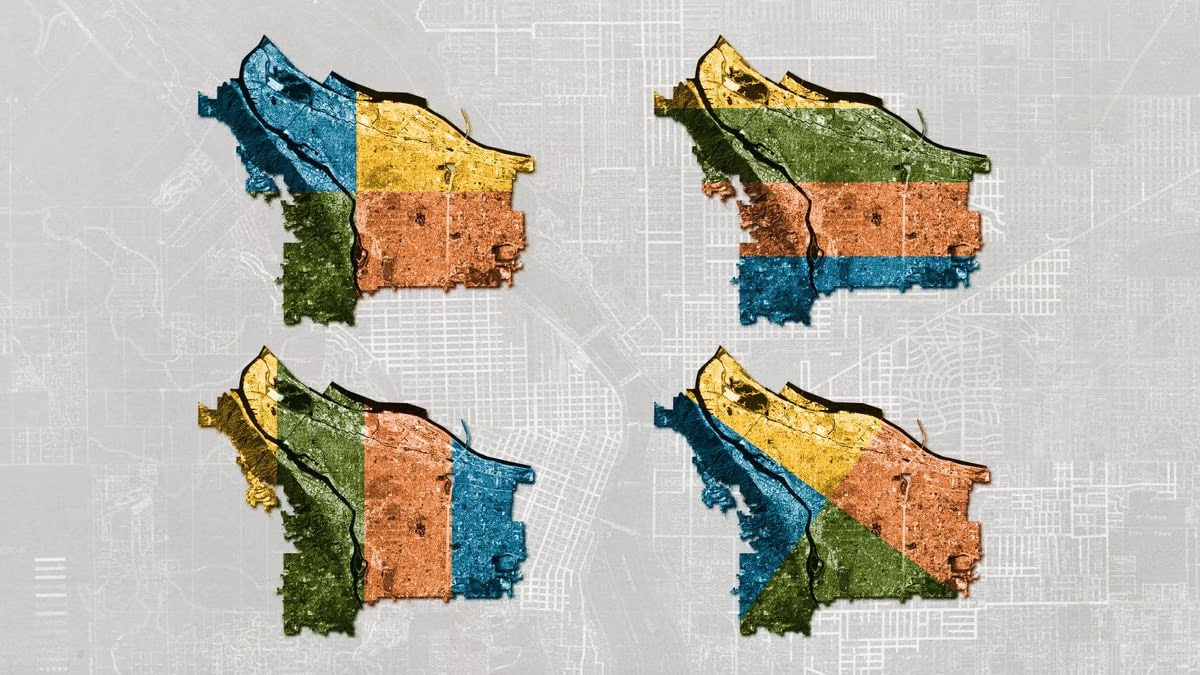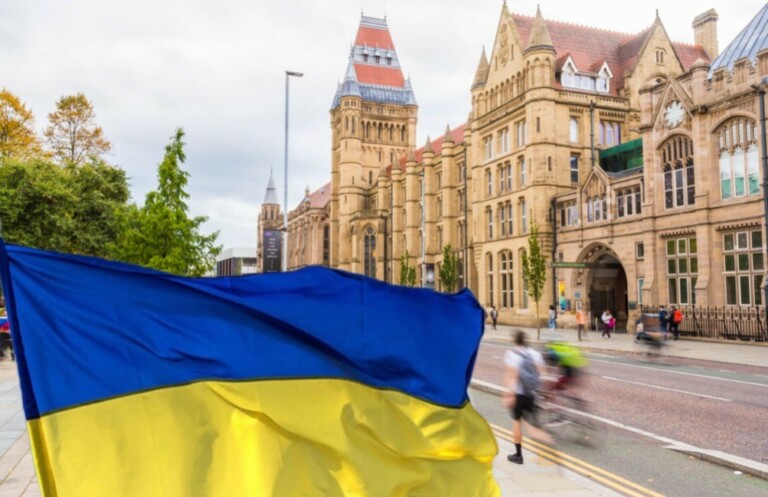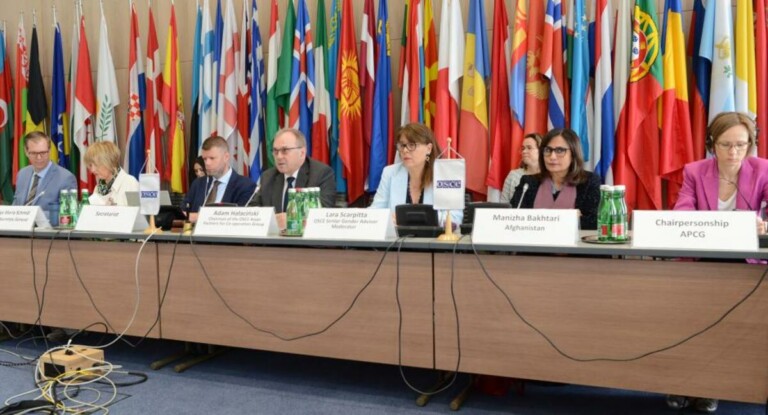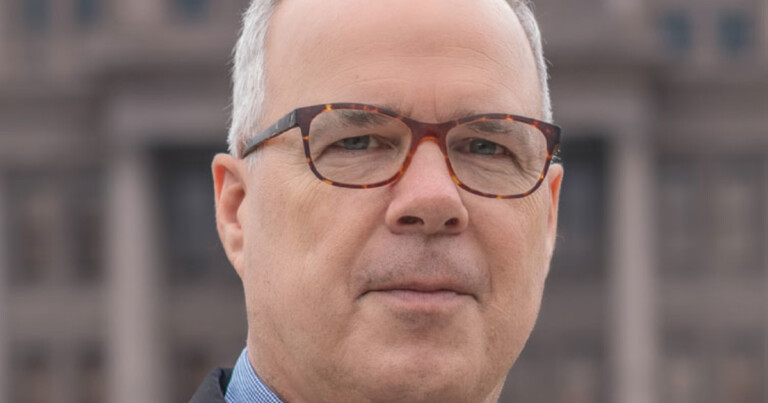Portland is months away from a historic makeover: By September, the city will have a new political map that divides the city into four districts, setting the stage for the 2024 election where voters select city council members to represent each district.
The city has entrusted a 13-person volunteer board — called the Independent District Commission — with the considerable task of deciding where these new district boundaries will fall.
“This is a once-in-a-generation opportunity to shape city government,” said Marta Hanson, commission co-chair and a staff member at Power the Polls, a national nonprofit that works to recruit election workers.
The group has spent the past four months reviewing and discussing draft maps submitted by the public. This month, they’ll choose one or more potential maps and ask Portlanders what they think. The commission must decide on a final district map by the end of August.
The whirlwind process comes with some parameters, but not many, leaving the commission reliant on public input to hammer out the details. The process has raised critical questions among Portlanders about the ways the city has historically divided itself and what representation means to Portlanders who’ve felt ignored in City Hall due to where they live.
The group’s final product will be a blueprint for a new era of political representation in Portland. While future city boards will be able to adjust the boundaries of the proposed districts, they won’t be able to completely re-draw where the districts fall. It’s a responsibility commission members don’t take lightly.
“This is different from a redistricting process,” said Paul Lumley, a commissioner co-chair and director of the Native American Youth and Family Center. “So we have to get it right the first time. We can’t make big mistakes. There’s no going back from what is decided.”
If at least nine of the 13 commission members approve a final district map in August, it will go into effect. If fewer than nine support the map, the decision will go to City Council for a final vote.
The criteria for setting Portland’s new districts
Portland council members are currently elected citywide, and are assigned to oversee city departments — like the water, police or housing bureaus — rather than geographic areas. Portlanders have long criticized this structure for inserting politics into sweeping decisions around basic city services. Without district representation, commissioners are not required to equally represent all Portlanders, causing skeptics to wonder if elected officials are only serving the needs of local power brokers who will help keep them in office. Despite constant criticism, Portland voters have rejected proposals to abandon this form of government eight times.
That resistance to change lasted until November 2022, when voters approved an amendment to Portland’s charter that dissolved this 110-year-old format and set the course toward a new system.
The amendment expands the council to 12 members and instructs the city to create four political districts. Voters will elect three council members to represent each district. The mayor, who will no longer serve as a member of city council, will still be elected citywide. This new system must be in place by November 2024.
The charter amendment includes criteria for establishing new districts. The four districts must be equal in population size, contiguous, be connected by road, and take into account existing geographic and political boundaries. They cannot divide “communities of common interest” and cannot be drawn “for the purpose of favoring any political party” or “for the purpose of diluting the voting strength of any language or ethnic minority group.”
The population limit means each district must have around 163,000 residents. This means district lines won’t necessarily reflect the familiar, informal boundaries Portlanders have long relied on to divide the city.
Based on recent US Census numbers, a total 144,000 Portlanders live west of the Willamette River, meaning a westside district would need to include some eastside residents. Around 202,000 Portlanders live north of Interstate 84 on the east side of the Willamette, and 173,000 people live east of 82nd Avenue. And more than 255,000 people make up Southeast Portland.
Of the nearly 200 maps submitted online by the public, some split the city into four horizontal layers spanning the Willamette, others resemble a pinwheel starting in inner Southeast Portland and stretching to the city’s limits. Others turn the city into a bullseye. Other maps attempt to follow the boundaries of Portland’s neighborhoods.
Keeping neighborhood voices
Absent legislative districts, Portland’s 90 neighborhoods have served as the city’s sole form of geographic representation for decades.
Neighborhood associations have long been allowed unique access to City Hall, with city requirements to notify associations of any city changes that could impact their neighborhood and to offer neighborhoods financial support. Public testimony sent to the Independent District Commission reflects a shared interest by the public to not split neighborhoods with the new districts. But other neighborhood leaders say they wouldn’t be upset if their neighborhood was split by a district line.
“I don’t see it being a problem — that means we would have twice as many representatives listening to us,” said Carol Chesarek, president of the Forest Park Neighborhood Association. “It doubles our chances of having an elected official that is passionate about things we are passionate about.”
Portlanders have already seen this play out eight miles to the east of Chesarek’s neighborhood. The 2-square-mile Montavilla neighborhood is represented by two state representatives and two electric companies. It also straddles both East Burnside Street and 82nd Avenue, two informal city boundary lines. But Jacob Loeb, Montavilla Neighborhood Association chair, fears that the additional representation offered by dividing the neighborhood into multiple city districts could dilute his community’s voice.
“It’s great to have multiple people to talk to about an issue, but it might be hard to associate responsibility among representatives and have them point fingers at each other instead,” Loeb said. “There is such a thing as having too many people to ask for help.”
‘Communities of common interest’
Representation is central to conversations at Independent District Commission meetings. One of the group’s requirements is to not divide “communities of common interest,” a vague term that the commission defines as groups that “share common policy concerns.” To commission co-chair Lumley, that primarily means communities with shared cultural backgrounds.
Lumley has spent the past few months speaking with representatives from immigrant groups and communities of color to ensure their interests are reflected in the final maps. He points to East Portland’s Jade District, where a growing population of immigrants work and live, as an example. The Jade District loosely stretches between Southeast 82nd Avenue and Interstate 205 between East Burnside Street and Southeast Powell Boulevard.
“In the Jade District, you have Asian-owned businesses that are community hubs, and they cut through traditional neighborhood boundaries,” Lumley said. “We want to make sure that we’re not separating these communities inadvertently by just following neighborhood lines.”
John Washington is concerned that the districting process will further weaken the political power of Portland’s Black community. Washington is the chair of the Soul District Business Association, a district that spans North and inner Northeast Portland. The Soul District was built to support Black-owned businesses in Portland’s historically Black neighborhoods that are increasingly threatened by gentrification. Washington fears that a move to divide the region into separate districts will further splinter an already fractured community.
“The state has historically fragmented us because they feared the collective nature of Black community,” Washington said. “I’m afraid this process may — intentionally or not — attempt to do the same.”
Some communities of color see geographic division as key to fair representation. Ana Muñoz, director of community engagement at the nonprofit Latino Network, recently met with members of Academia de Líderes, a Latino Network program that builds leadership and advocacy skills for Latino Portlanders. She explained the districting process and asked for members’ thoughts on the options.
Muñoz said the group agreed that a district that stretched east to west — looping in both East Portland’s Latino population and more affluent neighborhoods in the city center — would serve them better than just focusing a district on Latino community hubs.
“What they know is that there is a lack of resources for communities in the east,” Muñoz said. “If a district included people from both the east and west, East Portlanders’ issues might be treated more seriously by the city — and that their neighbors to the west would actually be aware of their needs.”
Public input
The volunteers tasked with drawing district lines are realistic about what their maps will be able to achieve.
“I think a lot of us see this as an opportunity to hear the needs of communities who have perhaps been historically excluded from our democratic systems,” Independent District Commission co-chair Hanson said. “But one map is not going to remedy all historic inequities. It’s our hope that this process can be one step in the right direction.”
To achieve that, Hanson said, their group must hear from as many different Portlanders as possible.
It’s particularly important based on recent history: Last year, Portlanders and public officials alike criticized the volunteer-led process to amend the city charter for not doing enough to ensure the group heard critiques, concerns and observations from enough residents. The 20-person charter commission held four community meetings over seven months to help shape the charter reform measure before referring the proposals to the November 2022 ballot. The Independent District Commission will be squeezing at least eight community meetings into the month of July — following five months of regular public hearings — to inform their final proposal.
Shoshanah Oppenheim, the city employee overseeing the entire government transition process, still expects to hear the same concerns after the district map has been chosen.
“There were many Portlanders who think that we should have done [charter review] differently,” Oppenheim said. “And I think we’ll see the same thing play out with the work of the Independent District Commission.”
Public comments are already shaping the final district plan. In a May 17 Independent District Commission meeting, commissioners agreed to place a few limits on the types of district maps they’ll vote on at the end of May.
Specifically, the group will not consider maps that divide the region west of the Willamette River or ones that pull the St. Johns neighborhood into a westside district (commissioners appear more interested in attaching the Lloyd neighborhood to a westside district to meet population requirements). The group will also ignore map drafts that divide Portland neighborhoods east of Interstate 205.
Commissioners will vote proposed maps on May 31 and hold meetings through July before approving a final map by the end of August.
Lumley said he won’t feel entirely confident approving a final map if it’s missing one critical piece: Clarity.
“Whatever we decide, I want to make sure that the reason for why we made that decision is understood,” Lumley said. “And if we can’t explain it, then I think we’ll have failed.”
Source: OPB News




